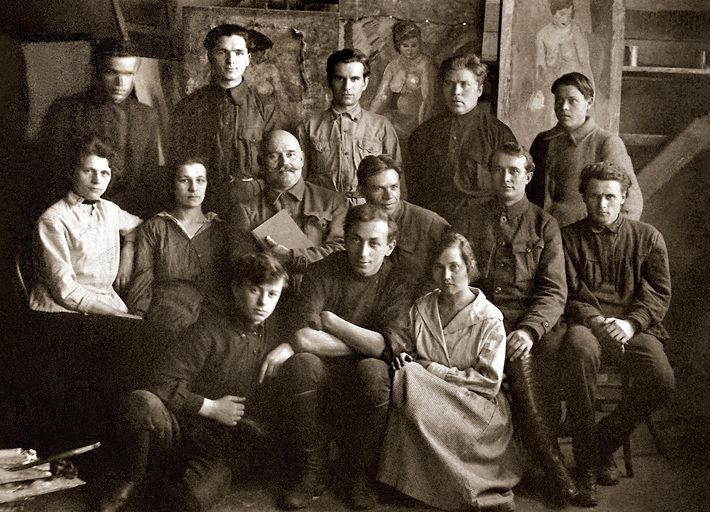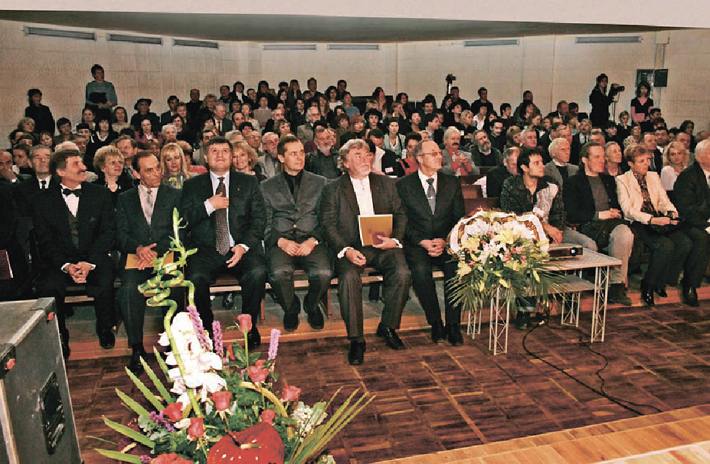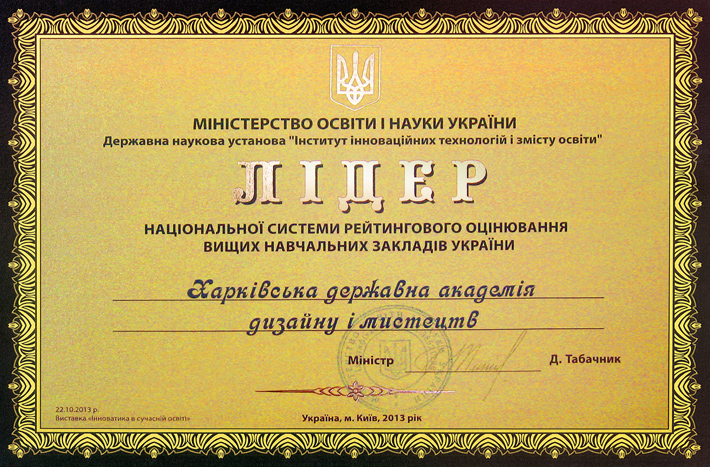HISTORY OF ACADEMY

Kharkiv State Academy of Design and Arts is one of the oldest art educational establishments in Ukraine.
In year 1768 so called additional classes were established under Kharkiv Collegium (the predecessor of Kharkiv University). Among those classes there was a class of Drawing which as a matter of fact turned into the first state art school in the province. It is notable that it was formed just 11 years after foundation of S.-Petersburg Academy of Arts (1757) which was the only art educational establishment in the Russian Empire at that time.
In the beginning of the 19th century the mission of art education was carried on by Kharkiv University after it was founded in 1805. The University and its founder V. Karazin made a major contribution to the outspread of art knowledge all over Slobozhanshchina, as well as in the south of the Russian Empire.
In 1869 M. Raevskaya-Ivanova’s School of Drawing was established in Kharkiv. It was an independent educational institution which followed the art-and-industrial course due to the fact that Kharkiv had turned by then into a large industrial centre. About 900 students got their art education at that school during 27 years. Not only ordinary specialists who devoted their lives to applied arts were its graduates, but famous in future artists and architects studied there as well, for example, great Ukrainian landscape painters S. Vasylkyvskyi and M. Tkachenko, Academician of Architecture O. Beketov, active participants of the Itinerants’ exhibitions O. Vyezzhayev and K. Pervukhyn. The great Russian painter P. Konchalovsky got his basic art education at M. Raevskaya-Ivanova’s School of Drawing.
In 1896 M. Raevskaya-Ivanova’s private school was turned into a municipal art school. Such graduates of the Academy as M. Pestrykov, M. Fedorov, K. Pyneyev gave their classes there.
A long-awaited event took place when Art College was founded in Kharkiv in 1912. The College was subordinate to S.-Petersburg Academy of Arts. O. Lyubymov was appointed to the position of the Director of the College after he was recommended to the post by his teacher I. Repin. To teach artistic subjects O. Lyubymov formed the faculty from I. Repin and D. Kardovysky’s students, namely O. Titov, S. Prokhorov, G. Gorelov, O. Kokel, and M. Fedorov
.Year 1921 was marked with the beginning of higher art education in Kharkiv. From 1922 till 1925 B. Korotko, a sculptor, was the Director of Kharkiv higher art school. In 1925-1927 the great Ukrainian landscape painter M. Burachek was the Rector of the Institute. A. Komashko who was I. Repin’s student, was at the head of the Institute during 1927-1933. Then up to 1941 I. Avgust, a fine art expert, managed the educational establishment. In 1920s-1930s such scholars worked at Institute as Professors S. Taranushenko, D. Gordeyev, L. Lenevych, famous artists A. Petrytsky, F. Krychevsky, G. Bondarenko, M. Samokysh, V. Kasyian, V. Myronenko, B. Kosarev, M. Derehus, B. Blank, M. Fradkyn, D. Ovcharenko, L. Kramarenko, M. Kozyk. Classes of plastic anatomy were given by the great scholar Academician V. Vorob’ev.

In 1941 when the World War II broke out, the Institute was evacuated to Samarkand (Uzbekistan).
Since 1943 Kharkiv art school’s traditions were carried on by such People’s Artists of Ukraine as V. Agibalov, H. Tomenko, V. Syzykov, O. Khmelnytsky, A. Konstantanynopolsky, as well as by Honoured Artists of Ukraine – Professors Ye. Yegorov, L. Chernovoy, O. Martynets, V. Lozovyi, Ye. Zherdzytsky, S. Solodovnyk, O. Vyatkyn, I. Karas, Associate Professors O. Kudryavtseva, I. Melgunova, P. Suponyn, Ye. Svytlychnyi, V. Vykhtynsky, M. Shaposhnykov, V. Volovyk, I. Stakhanov. During 1943-1948 S. Besyedin was the Rector of Kharkiv State Institute of Arts. From 1948 till 1972 the Institute was renamed Kharkiv Institute of Arts and Crafts and headed by M. Shaposhnykov.


In 1963 Kharkiv State Institute of Arts was reorganized into Kharkiv Art and Industrial Institute and restructured for preparing artists with industrial profile. It had two specialisations then. Nowadays the educational establishment offers ten specialisations.
From 1972 till 1985 the Institute was headed by Professor Ye. Yegorov.


During 1985-1998 Professor V. Torkatyuk was the Rector of the Institute.
In 1989 the standard doctorate was established; the Academic Council has worked at the Academy since 2002.
In 1992 Lyceum of Arts with a 2-year apprenticeship was founded.
Special training course for those appointed to posts began to work, as well as the department of advanced vocational training.

In August 2001Kharkiv State Academy of Design and Arts (IV level of accreditation) was founded as part of Khudprom in accordance with the Ordinance of the Cabinet of Ministers of Ukraine #364.
Since 1999 the Rector of the Academy is professor Academician V. Danylenko.

Almost 1450 people study at three faculties, among them there are students from Ukraine and 12 foreign countries, including the CIS.
Educational and methodological activity, creative work and research are carried out at 17 departments of the Academy by almost 200 lecturers, including 18 professors and 57 associate professors. 14 lecturers have honourary titles. Besides, the Academy has 4 lecturers who are members of the Academy of Arts of Ukraine, National Union of Artists, and Union of Designers of Ukraine.

KSADA is the only higher educational establishment which prepares designers of manufactured goods, specialists in such spheres as graphic design, interior designing, design of decorative textiles and clothes, commercial and industrial advertising, corporate look, and packing.
Our graduates successfully work at factories and in agencies in many segments of industry, in design organisations, business and industrial companies and associations, cultural and art organisations, higher schools, and colleges.


The Academy is also designated as a centre of the art culture.
It prepares highly qualified specialists who work in various spheres of artistry, namely easel painting, easel graphic works, book graphic works, poster, monumental-and-decorative painting and stained-glass window, architectural-and-decorative plastic arts and sculpture, and restoration of works of arts.



























 Department of Painting
Department of Painting
